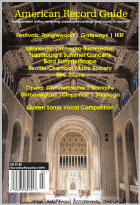Texte paru dans: / Appeared in: ECM 481816 |
|
|
Outil de traduction ~ (Très approximatif) |
|
|
Reviewer: Rob
Haskins This is a concert performance from 1987 in Troy, New York. I’ve never been able to recommend Jarrett’s Bach performances on harpsichord (see French Suites in M/J 1994). As a pianist, though, he is one of the best I know. His approach to WTC I is thoroughly pianistic while remaining what I hesitantly identify as “stylistically appropriate”. (I’ve come to feel that “stylistic appropriateness” can all too often create undue burdens for performers who have been hit in the head by
experts that there is only one
way to perform Bach.) Stylistic fidelity appears, I think, in the tempos,
which are almost all faster than my ideal. (Only the B-flat-minor fugue
approaches a genuinely slow tempo.) And yet Jarrett makes up for this with a
restrained lyricism that gives each contrapuntal line a clear, beautifully
phrased contour. Gould had this ability, too, but it seems more relaxed and
natural with Jarrett—perhaps a reflection of Gould’s late 1960s versus the
Jarrett’s late 1980s. A variety of articulation and pedal use abounds. He plays some passages in a single prelude completely dry, while to others he adds pedal to create a luminous splash of sound. I don’t know another pianist of recent vintage who does this with such spontaneity. With this he also creates a convincing shape for the individual pieces—no uniform volume, but subtle and sometimes marked changes that allow the progression of pieces a range of expressive stances. He also contra-dicts some of the typical expectations for the pieces: the subject of the E-major Fugue begins with two isolated eighth notes that are usually played with a cruel staccato. Jarrett connects them. (He uses the default nonlegato articulation sparingly, and when he does his technique creates lightness, sometimes playfulness, not a sense of a cruel machine stamping out auto car parts.)
One final thing I want to write about is the sudden appearance of a little ornamentation in the B-minor Fugue: just one little turn about three fourths from the end. I don’t believe I’ve ever heard such an ornament in this fugue, which often plods on like a dead march. It’s been prepared for by a more singing approach to the episodes, but it goes further, suggesting perhaps a little glimpse of a heavenly afterlife. Such music-making is so necessary, especially now. I’m thrilled to have this release; I only wish it had also been released on audiophile vinyl. | |
|
|
|
|
Cliquez l'un ou l'autre
bouton pour découvrir bien d'autres critiques de CD |
|




